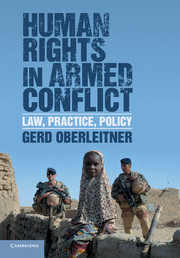Book contents
- Frontmatter
- Contents
- Acknowledgments
- Table of cases
- Table of Legal Instruments
- List of Abbreviations
- Introduction
- Part I Human rights in armed conflict: history of an idea
- Part II Human rights and humanitarian law: theory
- Part III Human rights and humanitarian law: challenges and commonalities
- 8 The right to life: the limits of human rights in armed conflict?
- 9 The extra-territorial application of human rights: functional universality
- 10 War as emergency: derogation
- 11 Human rights and humanitarian obligations
- 12 Operationalizing human rights in armed conflict
- Part IV The dynamics of war and law
- Part V Enforcement: practice and potential
- Conclusion
- Bibliography
- Index
- References
11 - Human rights and humanitarian obligations
Published online by Cambridge University Press: 05 March 2015
- Frontmatter
- Contents
- Acknowledgments
- Table of cases
- Table of Legal Instruments
- List of Abbreviations
- Introduction
- Part I Human rights in armed conflict: history of an idea
- Part II Human rights and humanitarian law: theory
- Part III Human rights and humanitarian law: challenges and commonalities
- 8 The right to life: the limits of human rights in armed conflict?
- 9 The extra-territorial application of human rights: functional universality
- 10 War as emergency: derogation
- 11 Human rights and humanitarian obligations
- 12 Operationalizing human rights in armed conflict
- Part IV The dynamics of war and law
- Part V Enforcement: practice and potential
- Conclusion
- Bibliography
- Index
- References
Summary
Reframing rights and obligations: respect, protect, fulfil
“Human rights law is centred, indeed built, on the granting of rights to the individual, while humanitarian law is focused on the direct imposition of obligations on the individual.” This view of the nature of the norms of the law of armed conflict – that international humanitarian law is about obligations and international human rights law about rights – is still widely used as an argument against their complementarity. As legal terms, “rights” and “obligations” differ, as does the corresponding terminology of “human rights” and “humanitarian law.” It has thus been argued that:
[t]he term “rights” in the expression “human rights” refers to subjective rights, powers or faculties which human beings possess in virtue of their recognition by national law and/or international law. The term “law” in “international humanitarian law” refers to an objective set of principles and rules which, in international law, govern the protection of individuals in international or internal armed conflict.
The difference can also be described with regard to rights-holders and duty-bearers: “international humanitarian law indicates how a party to a conflict is to behave in relation to people at its mercy, whereas human rights law concentrates on the rights of the recipients of a certain treatment.”
- Type
- Chapter
- Information
- Human Rights in Armed ConflictLaw, Practice, Policy, pp. 176 - 185Publisher: Cambridge University PressPrint publication year: 2015



